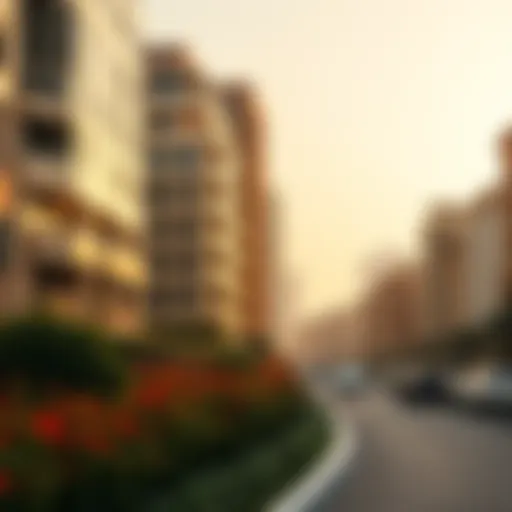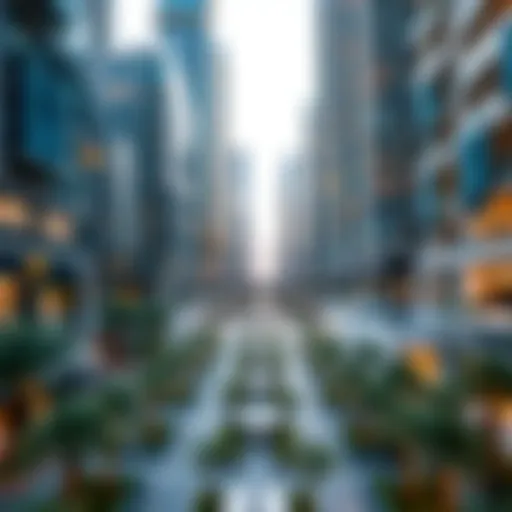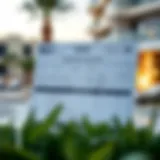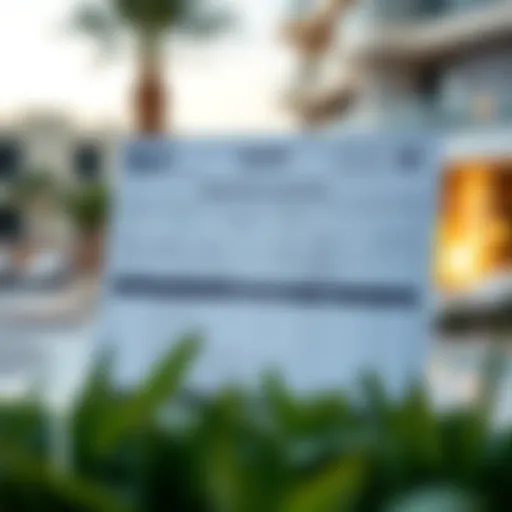Exploring the Dubai World Trade Center and Sheikh Rashid Tower
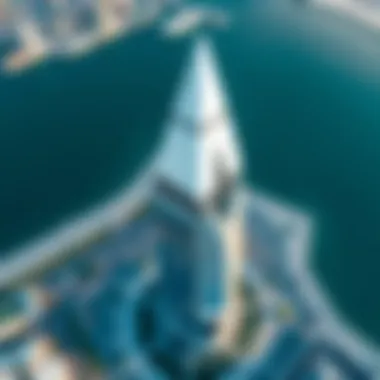

Intro
In the ever-evolving landscape of Dubai, the iconic silhouettes of the Dubai World Trade Center and Sheikh Rashid Tower stand tall, symbolizing not just architectural prowess but also the city's ambitious spirit. These buildings are not mere structures of glass and steel; they encapsulate the historical essence and economic vibrancy of a city that has, in a relatively short period, transformed into a global hub for trade and commerce. For investors, real estate agents, and homebuyers, understanding these landmarks and their influence on the market is crucial in navigating the complex and dynamic real estate environment of Dubai.
The Dubai World Trade Center, with its distinctive tapering form, was once the tallest building in the Middle East. Completed in 1979, it has continually adapted, serving as a focal point for the region's international business activities. Meanwhile, Sheikh Rashid Tower, also known as Burj Al Khalifa per the historical context, contributes to the saturation of high-rise structures that define the skyline.
In the sections that follow, we will delve into the architectural significance, historical context, and aesthetic appeal of these structures. We will also explore their impact on property values and investment opportunities in the surrounding regions, motivated by a keen interest to inform those looking to stake a claim in Dubai's vibrant real estate market.
\n
Market Trends in Dubai Real Estate
Current Market Overview
The real estate market in Dubai shows a level of resilience that’s remarkable, especially in light of global economic shifts. Over the past few years, there’s been notable stability with a resurgence in demand for commercial and residential properties alike. The rise of the Dubai World Trade Center as a business hub has been instrumental in driving investments into adjacent areas like Sheikh Rashid Tower.
As the city positions itself as a thriving center for tourism and business, more buyers, especially expatriates, are keen on entering the market. It’s important for potential investors to keep tabs on the latest regulations, property prices, and market dynamics to make informed decisions.
Price Trends and Forecasts
When it comes to property pricing, recent trends indicate a steadiness that can be attributed to improved economic conditions and increased foreign investments. The average rental prices for residential units, particularly around the World Trade Center and Sheikh Rashid Tower, have seen a slight uptick over recent months.
- Prices are expected to stabilize as supply meets demand, particularly in high-demand areas.
- Commercial properties are showcasing higher yields, making them attractive ventures for investors.
- New developments are sparking interest across various sectors, particularly in hospitality and retail spaces.
Thus, for property enthusiasts and investors, now might be the right time to explore opportunities that offer both immediate returns and long-term growth potential. The interplay of historical legacy and modern demand in this vibrant city creates a rich tapestry for exploration and investment.
Prolusion to Dubai's Iconic Structures
Dubai's skyline is a feast for the eyes, a tapestry of buildings that reflect the city’s relentless ambition and innovation. This section aims to offer insights into two of the most recognizable structures, the Dubai World Trade Center and Sheikh Rashid Tower. Firmly rooted in the history and culture of the UAE, these towers are not merely architectural wonders; they symbolize the aspirations and dynamism of this vibrant metropolis.
Understanding these iconic structures means grasping the very essence of Dubai—its rise as a hub for global commerce and culture. As buildings evolve over time, they often take on a life of their own, becoming more than just their intended purpose. They blend functionality with aesthetic appeal and service myriad roles, from business centers to cultural landmarks. It’s vital to see these towers through a multifaceted lens that encapsulates their architectural brilliance, historical themes, and economic roles.
Overview of Dubai's Architectural Landscape
Dubai's architectural landscape is nothing short of extraordinary, characterized by a striking blend of modern design and cultural influences. The city is a living canvas, showcasing the creativity and ambition of architects and builders from around the globe. From the twisting silhouette of the Burj Khalifa to the waves of design in the UAE Pavilion, each building tells a story that transcends mere construction.
Several architecture firms play key roles in reimagining urban space, providing a progressive outlook not just for Dubai but the entire region. Notably, the Dubai World Trade Center, completed in the early 1970s, stands as a testament to the Emirates' vision and economic aspirations. In contrast, Sheikh Rashid Tower, which was built later, reflects the vibrant culture of Dubai's growth post-oil boom.
The towers serve as pivotal landmarks for both locals and visitors, offering panoramic views that highlight the vastness and rich tableau of Dubai. They allow us to witness the continual evolution of this city and serve as navigation points in the sprawling urban landscape.
Cultural Significance of Towers in Dubai
The significance of towers in Dubai extends above their physical presence. They resonate with cultural meaning, acting as symbols of progression and hope. The Dubai World Trade Center, for instance, played a critical role in establishing Dubai as a global financial center, inviting businesses from across the world to set up shop in the bustling metropolis.
Towers such as Sheikh Rashid Tower embody the storytelling tradition of the region, celebrating local heritage while pushing architectural boundaries. They are not merely structures of steel and glass; they reflect the social and economic narratives of a society in transition.
"Buildings are not just structures; they are reflections of the society in which they stand."
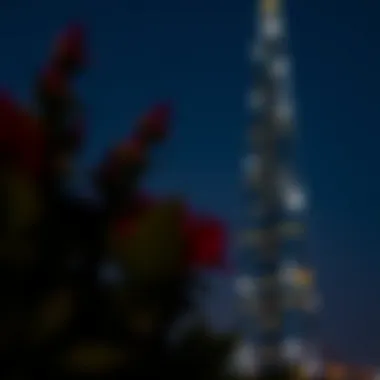

Furthermore, these towers are integral to architectural identity. They pave the way for innovative designs and foster a sense of pride among Emiratis. This architectural spectacle defines Dubai, leaving an indelible mark on the burgeoning real estate market, attracting investors, homebuyers, and businesses alike.
As we delve deeper into the history and design of these towers in subsequent sections, it becomes increasingly clear that they’re more than skyscrapers; they are milestones on Dubai's journey toward becoming a global powerhouse, shaping not only the skyline but also the very essence of urban living.
The Dubai World Trade Center Tower: A Historical Overview
The Dubai World Trade Center (DWTC) Tower is not just an architectural marvel; it is a pivotal part of Dubai's transformation into a bustling hub of commerce and trade. When exploring the historical context of this iconic tower, one discovers its relevance in shaping the economic landscape of the region. The DWTC has stood tall since its completion in 1979, symbolizing ambition and forward-thinking that the UAE embraced in the late twentieth century. Understanding its history provides insight into how Dubai positioned itself on the global stage.
Construction and Development Timeline
The story of the Dubai World Trade Center begins in the 1970s when the United Arab Emirates was still in its infancy as a nation. The idea to construct a trade center was put forth in 1974, as the rulers recognized the need to establish a focal point for international business in the region. The groundwork commenced in October 1975, and after four years of intense labor and resource allocation, on the dawn of a new decade, the tower was officially inaugurated in 1979.
Here are some key milestones in its construction:
- 1974: Initial proposal for a trade center introduced.
- 1975: Groundbreaking event, marking the start of construction.
- 1979: Opening ceremony attended by prominent local and international dignitaries, celebrated as a game-changer for Dubai.
The DWTC underwent several expansions and renovations over the years to adapt to the city's growing demands. Its development reflects Dubai's shifting focus from oil dependency to a diverse economy that leverages trade and tourism.
Architectural Features and Design Principles
The architectural brilliance of the Dubai World Trade Center is evident in its unique design—it's not just another skyscraper. The DWTC reaches a height of 321 meters, making it one of the tallest buildings in the UAE at the time of its completion.
- Art Deco Influence: The tower features distinct Art Deco elements, a nod to 20th-century architectural styles that evoke both elegance and stature.
- Triangular Prism Shape: The tower's unique three-sided design not only creates a striking silhouette against the Dubai skyline but also promotes structural integrity in high winds.
- Reflection of Local Culture: The panoramic views provided by its height showcase the city’s evolving landscape and desert surroundings, linking the traditional and modern aspects of Dubai.
The design principles behind the structure optimally balance functionality and aesthetics. Its vast interior space hosts numerous offices, event venues, and exhibition spaces, pivotal for hosting international conferences and trade shows.
Role in Global Trade and Business
In its essence, the Dubai World Trade Center is more than just a tower; it has been a catalyst for global trade. Hosting numerous conferences and business events, the DWTC offers a platform for international companies to connect and collaborate. The significance of this role can be summarized in several points:
- International Expo: It has been the venue for major international expos, showcasing Dubai's capabilities to host global events.
- Business Hub: As home to the Dubai Chamber of Commerce, it plays a crucial role in facilitating business growth and trade within the region.
- Networking Opportunities: The DWTC serves as a meeting place for trade missions from around the world, effectively bridging businesses with opportunities.
Overall, the Dubai World Trade Center stands as a beacon of commerce, continually influencing the architectural and economic landscape of Dubai. It is an exemplar of how a single structure can reshape the identity of a city and amplify its presence in the worldwide marketplace.
Sheikh Rashid Tower: A Symbol of Progress
The Sheikh Rashid Tower stands as a beacon of architectural prowess and economic ambition in Dubai. This structure is more than just steel and glass—it salutes the city’s evolution from a modest fishing village to a global hub of trade and commerce. As we dissect the various facets of the Sheikh Rashid Tower, we can appreciate its vital role in shaping Dubai’s identity and its trajectory into the future.
Historical Context and Development
Construction of the Sheikh Rashid Tower commenced in the early 1970s, a period when Dubai was laying the groundwork for what it would eventually become. The vision behind the tower was to provide a central point for business activity in the emirate and demonstrate to the world that Dubai was ready to compete on a global scale. Officially opened in 1979, the tower was one of the first skyscrapers in Dubai and, at the time, the tallest building in the Middle East. This timing was crucial: it coincided with a massive oil boom which fueled rapid development in the region.
When the local economy began to diversify, leading to growing sectors like tourism and services, the Sheikh Rashid Tower became a focal point, symbolizing progress and ambition.
Design Elements and Aesthetic Appeal
Architecturally, Sheikh Rashid Tower is a striking blend of modernist and traditional Islamic styles. The design integrates large, reflective glass facades with elegant, curved shapes—these features not only enhance the visual appeal but also serve practical purposes regarding energy efficiency and lighting.
The interior is as stunning as the exterior. Sweeping lobbies, high ceilings, and art installations provide an upscale atmosphere conducive to business and entertainment. Every corner of the building is meticulously planned to embody luxury and functionality, attracting high-profile tenants and visitors alike.
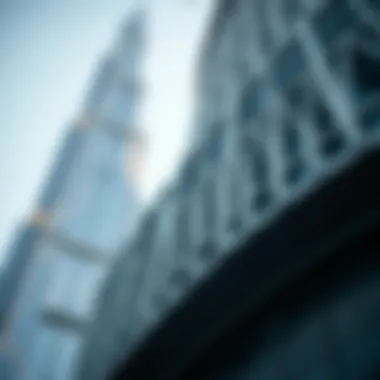

Impact on the Local Economy and Real Estate
The Sheikh Rashid Tower has had a profound impact on the local economy. It serves as a primary business hub, housing numerous multinational corporations and offices, which generates significant employment and economic activity. Its presence on the skyline has also had a halo effect on surrounding real estate, driving up property values and encouraging investment.
Furthermore, as more businesses establish their presence in and around the tower, there is a corresponding growth in the services sector, from retail to hospitality. This symbiotic relationship between the tower and local businesses underscores its importance in not just real estate dynamics but the broader economic framework of Dubai.
"The Sheikh Rashid Tower isn't just a building; it's a symbol of Dubai’s ambition to stand tall on the world stage."
Comparative Analysis of the Two Towers
It’s crucial to dive into how the Dubai World Trade Center and Sheikh Rashid Tower not only exemplify the architectural prowess of their time but also represent different facets of Dubai's rapid development as a global business hub. By comparing these two iconic structures, we uncover insights that extend beyond just their designs. We’ll explore their unique architectural styles, the influences that shaped them, and their contributions to the dynamic skyline of Dubai. This analysis ensures a fuller understanding of how these towers have evolved with the city itself and their lasting impact on the real estate landscape.
Architectural Style and Influence
The architectural styles of the Dubai World Trade Center and Sheikh Rashid Tower reflect distinct cultural influences and aesthetic sensibilities. The World Trade Center, completed in 1979, is a testament to the late modernist architecture that was prevalent during its construction. Its sharp lines and geometric shapes showcase a pragmatic approach to urban architecture, aimed at functionality while still ensuring a striking silhouette against the skyline. The tower includes a blend of glass and steel that not only serve its structural purpose but also contribute to its shiny, reflective facade.
In contrast, Sheikh Rashid Tower, completed in 1995, takes on a more postmodern approach. The design features a combination of modern elements together with Islamic architectural motifs, bridging cultural heritage with contemporary trends. Its rounded edges and extensive use of natural light create a softer profile amidst the more angular shapes of its peers. This stylistic difference isn't merely cosmetic; it communicates a narrative of progress and fusion that resonates with Dubai’s identity.
The influences on both structures are also noteworthy. The World Trade Center was influenced by global architectural trends of the time, often aiming to project power and stability. Sheikh Rashid Tower, on the other hand, embodies the local culture while also looking outward, reflecting globalization’s impact on architecture. The carefully chosen materials for both buildings further underscore this; while the World Trade Center prefers sleek industrial materials, Sheikh Rashid Tower often incorporates more traditional fare which makes it stand out as a symbol of local pride.
Contributions to the Skyline of Dubai
The contributions of these towers to the Dubai skyline can’t be overstated. The World Trade Center was one of the first modern skyscrapers in Dubai, setting a precedent for future developments. Its height and distinct style made it an immediate focal point, drawing businesses and visitors alike. It symbolized the city’s aspirations to be a player on the global stage, catching the eye of investors and multinational corporations seeking a foothold in the rapidly growing economy.
In contrast, Sheikh Rashid Tower has become more than just an office building; it's a landmark of thriving Dubai commerce. Its integration of local design elements not only enhances the skyline but also serves as a reminder of Dubai's cultural roots amid its rapid modernization. As Dubai continues to evolve, the Sheikh Rashid Tower stands as a bridge between the past and future, encapsulating the city’s identity.
In summary, while both towers showcase impressive designs and critical roles in Dubai’s development, their unique architectural styles and contributions to the skyline offer distinct narratives that enrich the city’s historical context.
"The juxtaposition of these two towers illustrates the balance between heritage and modernity, showcasing how Dubai has crafted a narrative that is uniquely its own."
The discussion surrounding these structures ultimately provides valuable insights for investors, homebuyers, and real estate agents, guiding them to understand the deeper implications of such architectural landmarks in shaping the market and lifestyle in the heart of Dubai.
The Visual Narrative: Sheikh Rashid Tower Photos
In any architectural wonder, the visuals serve as a crucial conduit, telling stories that numbers and plans simply cannot convey. The Sheikh Rashid Tower, a landmark in Dubai, embodies a perfect intersection of art and functionality. The photographs capturing this structure not only frame its physical aspects but also encapsulate the essence of Dubai’s relentless ambition and evolving aesthetic. By examining the visual narrative surrounding Sheikh Rashid Tower, we can glean deeper insights into what makes this building a vital component in the city’s architectural lexicon.
Photography as an Art Form in Architecture
Photography transcends its fundamental purpose of documentation to become an art form in itself, especially in the realm of architecture. The lens doesn’t merely record; it interprets, reflects, and even distorts reality to offer fresh perspectives. Emotionally charged images can evoke the aspirations that a structure stands for, whereas straightforward photos might miss the subtleties that connect the observer to its environment.
When photographing Sheikh Rashid Tower, the focus often shifts from mere aesthetics to the narrative it conveys. For example, a shot taken at dusk, with the tower illuminated against the twilight sky, evokes a sense of awe and captures the spirit of Dubai as a modern-day metropolis. Moreover, candid shots of people interacting with the building showcase how Sheikh Rashid Tower serves as more than just a workspace but as a cultural landmark that resonates within the community.
Captured Moments: Iconic Views of Sheikh Rashid Tower
The investment in real estate in Dubai often hinges on perceptions shaped by its visuals. Those iconic views of Sheikh Rashid Tower underscore its significance, not just architecturally but socially. The most notable captures often highlight the contrast between traditional Arabian design and modernist touches, illustrating a city in constant flux yet firmly rooted in its heritage.
For instance, consider a photograph of Sheikh Rashid Tower framed by the bustling streets below, juxtaposed with traditional souks nearby. This visual speaks volumes, demonstrating how the tower is a bridge between old and new—where cutting-edge business meets historical cultural essence.
An extraordinary snapshot during the Dubai Shopping Festival could highlight the tower as a backdrop to vibrant festivities, capturing the essence of communal celebration in a rapidly urbanizing landscape. Such moments make evident the tower’s role as a pivotal point in Dubai’s cultural events, making it a subject of interest for both tourists and locals alike.
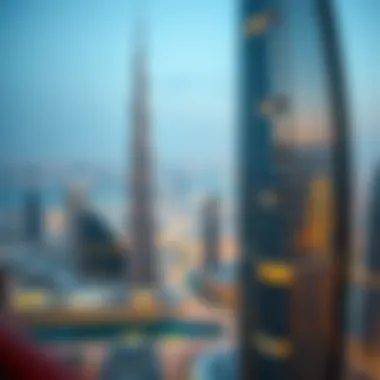

Analysis of Visual Impact in Urban Settings
Visual storytelling in urban landscapes, specifically through the lens of Sheikh Rashid Tower, holds great importance for investors and homebuyers. Analyzing the visual impact extends beyond artistic appreciation; it has practical implications that could affect property valuation and potential buyer interest.
The visual portrayal of Sheikh Rashid Tower has the power to shape perceptions—what one sees can significantly alter what one believes about a neighborhood or city. Well-composed images displaying the tower can highlights positive aspects such as vibrant life, safety, and accessibility, attracting foreign investments and tourists alike.
When the tower is depicted alongside lush public spaces or modern amenities, it creates an inviting narrative. Investors looking to buy property in its vicinity find merit in these visuals—they become a mental checklist of potential lifestyles available in the area. Therefore, as property enthusiasts engage with these images, they contextualize how the tower fits into their aspirations for home and investment.
"A picture is worth a thousand words, but in the context of architecture, it offers countless opportunities for reasoned decisions."
By evaluating the visual impact of Sheikh Rashid Tower against the backdrop of Dubai’s skyline, one can uncover layers of meaning that drive the urban narrative—a narrative rich with opportunities for both financial and aesthetic rewards.
The Towers' Contribution to Modern Real Estate Trends
The Dubai World Trade Center and Sheikh Rashid Tower stand as more than mere architectural symbols; they significantly shape the real estate landscape in Dubai. As gateways to the city’s dynamic property market, they attract diverse stakeholders—from domestic investors to multinational corporations. Understanding the impact of these towers not only reveals their relevance but also highlights trends influencing modern real estate.
Influence on Commercial Property Developments
The presence of the Dubai World Trade Center augments its surroundings, making it an attractive proposition for various commercial endeavors. Businesses that set up base near this hub experience a surge in their visibility and client reach. Here are some key elements:
- Proximity to Key Facilities: Its location facilitates easy access to essential services, transport links, and global markets, making it ideal for companies aiming for expansion.
- Networking Opportunities: The tower hosts numerous exhibitions and trade events, which fosters networking opportunities for businesses.
- Enhanced Market Reputation: Companies located in prestigious towers often enjoy increased credibility and enhanced reputation, vital for attracting new clients.
The Sheikh Rashid Tower complements this ecosystem, contributing through its strategic designs and modern facilities. The mixed-use space nurtures a synergy between residential, commercial, and tourism sectors, leading to a more integrated urban environment. This adaptability makes spaces within the tower attractive to retailers, office tenants, and even hospitality players.
Attraction for Foreign Investment
Foreign investment into Dubai’s property market surged alongside the iconic towers, reshaping perceptions and motivations for international buyers. The allure of the towers is rooted in several factors:
- Stable Investment Climate: Both towers exemplify stability and resilience, appealing to foreign investors looking for secure opportunities.
- Government Initiatives: Supportive policies that simplify ownership for foreign nationals directly contribute to the flourishing investment environment. Initiatives that incorporate investment safeguard and streamlined processes bolster investor confidence.
- High Returns on Investment: Properties in proximity to Dubai World Trade Center and Sheikh Rashid Tower are seen as lucrative, with the potential of high rental yields and appreciation, attracting international players aiming for profitable ventures.
Ultimately, the towers serve as beacons for investment interests, showcasing Dubai as a global hub for commerce and real estate.
"The Dubai World Trade Center and Sheikh Rashid Tower are catalysts for growth, influencing real estate trends and attracting international interest in the region."
Ending: The Future of Iconic Towers in Dubai
The evolution of iconic structures like the Dubai World Trade Center and Sheikh Rashid Tower marks a pivotal chapter in Dubai's architectural narrative. These skyscrapers don’t just scrape the sky; they reflect the aspirations and evolving identity of a city that never settles. The future of these towers is crucial, not only for preserving their historical legacy but also for ensuring they adapt to the changing tides of urban planning and architectural innovation.
Sustainable Development and Architectural Innovation
In an age where sustainability is paramount, the future of the Dubai World Trade Center and Sheikh Rashid Tower lies in their ability to incorporate green building practices. Sustainable development isn't just a trend—it's a necessity. For instance, the integration of energy-efficient systems, rainwater harvesting, and solar panels could transform these iconic towers into models of sustainability.
- Energy Efficiency: Modernizing the heating and cooling systems can lead to significant reductions in energy use.
- Green Roofs: By introducing green spaces in the form of roofs or terraces, these buildings can contribute to improving air quality and urban biodiversity.
- Smart Technologies: Implementing smart grids and IoT devices can enhance operational efficiency and provide real-time data on building performance.
These strategies aren't just about looking good on paper; they hold the potential to improve occupant comfort, reduce operational costs, and ultimately increase the value of the property. As investors and developers focus on long-term returns, the push for sustainability will shape decisions surrounding future renovations and constructions.
Enduring Legacy of the Dubai World Trade Center and Sheikh Rashid Tower
The enduring legacy of these towers is evidenced not only in their physical presence but also in their roles as economic catalysts. The Dubai World Trade Center was one of the first skyscrapers in the region, setting a benchmark for future constructions. Its impact on international trade and commerce continues to resonate. Similarly, Sheikh Rashid Tower symbolizes the ambition and resilience of Dubai's real estate market.
"The architecture of these towers stands as a testament to human endeavour; they remind us that progress isn't merely about height but the vision that propels us there."
Future generations will look back on these structures as pivotal points in the history of Dubai. As the city continues to grow, the legacy of such landmarks will serve as motivational pillars for emerging architects and city planners.
Investors and property enthusiasts must recognize that by supporting the enhancing of these towers, they are contributing to a narrative far greater than just real estate value. They are part of a journey that redefines urban spaces, fosters community well-being, and champions innovation within the architectural landscape of Dubai.

